
St. Stephen's Cathedral is the mother church of the Roman Catholic Archdiocese of Vienna and the seat of the Archbishop of Vienna, Christoph Cardinal Schönborn, OP. The current Romanesque and Gothic form of the cathedral, seen today in the Stephansplatz, was largely initiated by Duke Rudolf IV (1339–1365) and stands on the ruins of two earlier churches, the first a parish church consecrated in 1147. The most important religious building in Vienna, St. Stephen's Cathedral has borne witness to many important events in Habsburg and Austrian history and has, with its multi-coloured tile roof, become one of the city's most recognizable symbols.

Cosmas Damian Asam was a German painter and architect during the late Baroque period. Born in Benediktbeuern, he lived in Rome from 1711 to 1713 to study at the Accademia di San Luca with Carlo Maratta. In 1713, Asam won the Academy's first prize for his drawing of Miracle of Saint Pio. In Germany, he worked with his brother Egid Quirin, a sculptor and stucco worker, on building and decorating entirely new churches or redesigning churches in the Baroque style. Their joint projects are often attributed to the "Asam Brothers". Cosmas Damian died in Munich.
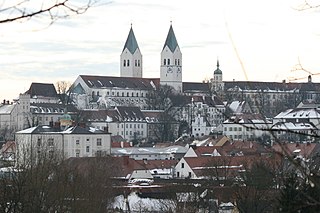
Freising is a university town in Bavaria, Germany, and the capital of the Freising Landkreis (district), with a population of about 50,000.
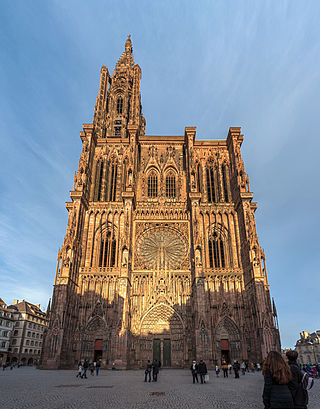
Strasbourg Cathedral or the Cathedral of Our Lady of Strasbourg, also known as Strasbourg Minster, is a Catholic cathedral in Strasbourg, Alsace, France. Although considerable parts of it are still in Romanesque architecture, it is widely considered to be among the finest examples of Rayonnant Gothic architecture. Architect Erwin von Steinbach is credited for major contributions from 1277 to his death in 1318, and beyond through his son Johannes von Steinbach, and his grandson Gerlach von Steinbach, who succeeded him as chief architects. The Steinbachs's plans for the completion of the cathedral were not followed through by the chief architects who took over after them, and instead of the originally envisioned two spires, a single, octagonal tower with an elongated, octagonal crowning was built on the northern side of the west facade by master Ulrich von Ensingen and his successor, Johannes Hültz. The construction of the cathedral, which had started in the year 1015 and had been relaunched in 1190, was finished in 1439.

Saint Corbinian was a Frankish bishop. After living as a hermit near Chartres for fourteen years, he made a pilgrimage to Rome. Pope Gregory II sent him to Bavaria. His opposition to the marriage of Duke Grimoald to his brother's widow, Biltrudis, caused Corbinian to go into exile for a time. His feast day is 8 September. The commemoration of the translation of his relics is 20 November.

The Frauenkirche is a church in Munich, Bavaria, Germany, that serves as the cathedral of the Archdiocese of Munich and Freising and seat of its Archbishop. It is a landmark and is considered a symbol of the Bavarian capital city. Although called "Münchner Dom" on its website and URL, the church is referred to as "Frauenkirche" by locals.

Speyer Cathedral, officially the Imperial Cathedral Basilica of the Assumption and St Stephen, in Latin: Domus sanctae Mariae Spirae in Speyer, Germany, is the seat of the Roman Catholic Bishop of Speyer and is suffragan to the Roman Catholic Archdiocese of Bamberg. The cathedral, which is dedicated to St. Mary, patron saint of Speyer and St. Stephen is generally known as the Kaiserdom zu Speyer. Pope Pius XI raised Speyer Cathedral to the rank of a minor basilica of the Roman Catholic Church in 1925.
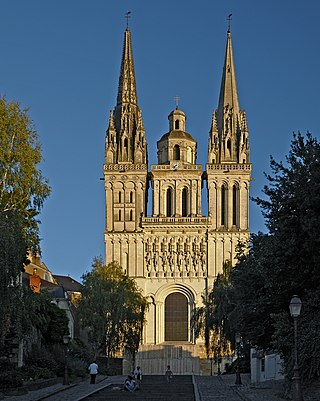
Angers Cathedral is a Roman Catholic church dedicated to Saint Maurice in Angers, France. It is the seat of the Bishops of Angers.

Egid Quirin Asam was a German plasterer, sculptor, architect, and painter. He was active during the Late Baroque and Rococo periods.

Basel Minster is a religious building in the Swiss city of Basel, originally a Catholic cathedral and today a Reformed Protestant church.

Innichen Abbey is a former Benedictine monastery in Innichen, South Tyrol in northern Italy. Founded in the 8th century, its collegiate church dedicated to Saint Candidus, rebuilt in the 12th–13th centuries, is considered the most important Romanesque building in Tyrol and the Eastern Alps. It is home to a 13th-century sculpture and a fresco cycle from the same age in the dome.
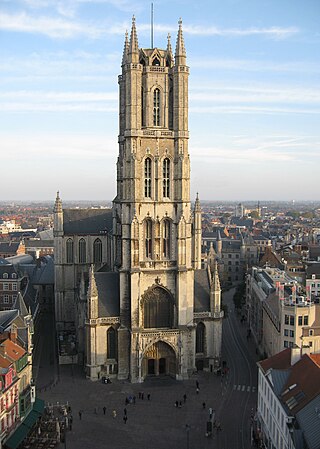
Saint Bavo's Cathedral, also known as Sint-Baafs Cathedral, is a cathedral of the Catholic Church in Ghent, Belgium. The 89-meter-tall Gothic building is the seat of the Diocese of Ghent and is named for Saint Bavo of Ghent. It contains the well-known Ghent Altarpiece.

Santiago Metropolitan Cathedral is the seat of the Archdiocese of Santiago de Chile and the main temple of the Catholic Church in that country. As a Cathedral Church, it is the permanent seat of the Archbishop of Santiago and is dedicated to the Assumption of the Virgin Mary.

Saint Thomas Church is an Augustinian church in Malá Strana, Prague, Czech Republic. The address is at Josefská 8. The church is easily recognisable in the Prague skyline. Saint Thomas' Church stands within the vicinity of both Saint Nicholas' Church and the Castle of Prague. In 2003, Saint Thomas Church celebrated its 775 anniversary.

Volterra Cathedral is a Roman Catholic cathedral in Volterra, Italy, dedicated to the Assumption of the Virgin Mary. It is the seat of the bishop of Volterra.

Innsbruck Cathedral, also known as the Cathedral of St. James, is an eighteenth-century Baroque cathedral of the Roman Catholic Diocese of Innsbruck in the city of Innsbruck, Austria, dedicated to the apostle Saint James, son of Zebedee. Based on designs by the architect Johann Jakob Herkomer, the cathedral was built between 1717 and 1724 on the site of a twelfth-century Romanesque church. The interior is enclosed by three domed vaults spanning the nave, and a dome with lantern above the chancel. With its lavish Baroque interior, executed in part by the Asam brothers, St. James is considered among the most important Baroque buildings in the Tyrol.

Chur Cathedral, otherwise known as the Cathedral of the Assumption of Mary, is the Catholic cathedral of the diocese of Chur in Switzerland. The episcopal palace of the bishop of Chur is beside the church. The cathedral claims the relics of St Lucius of Britain, said to have been martyred nearby in the late 2nd century. During the Swiss Reformation, the Catholic population of the city were confined to a ghetto enclosed around the bishop's court beside the cathedral. It is a Swiss heritage site of national significance.
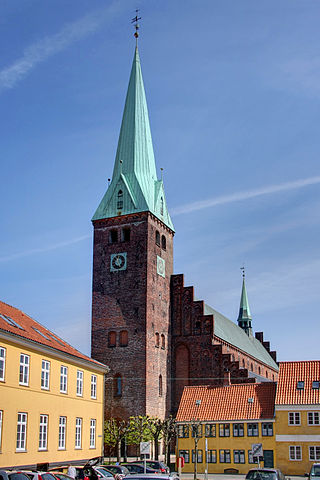
Saint Olaf's Church is the cathedral church of Helsingør in the north of Zealand, Denmark. With a history going back to around 1200, the present building was completed in 1559. In 1961, the church was given the status of cathedral in connection with the establishment of the Diocese of Helsingør.

St. Paul's Church is a Roman Catholic church located at the Veemarkt in Antwerp, Belgium. Its exterior is mainly Gothic with a Baroque tower while the interior is characterised by its rich Baroque decoration. It holds paintings by Antwerp's leading artists Peter Paul Rubens, Anthony van Dyck and Jacob Jordaens as well as abundant sculpture and church furniture crafted by leading Antwerp sculptors such as Artus Quellinus the Elder, Pieter Verbrugghen I, Jan Pieter van Baurscheit de Elder, Jan Claudius de Cock and Andries Colyns de Nole. Of particular note is the Calvary outside the Church which is made up of 63 life-size statues and nine reliefs executed in a popular and theatrical style.





















